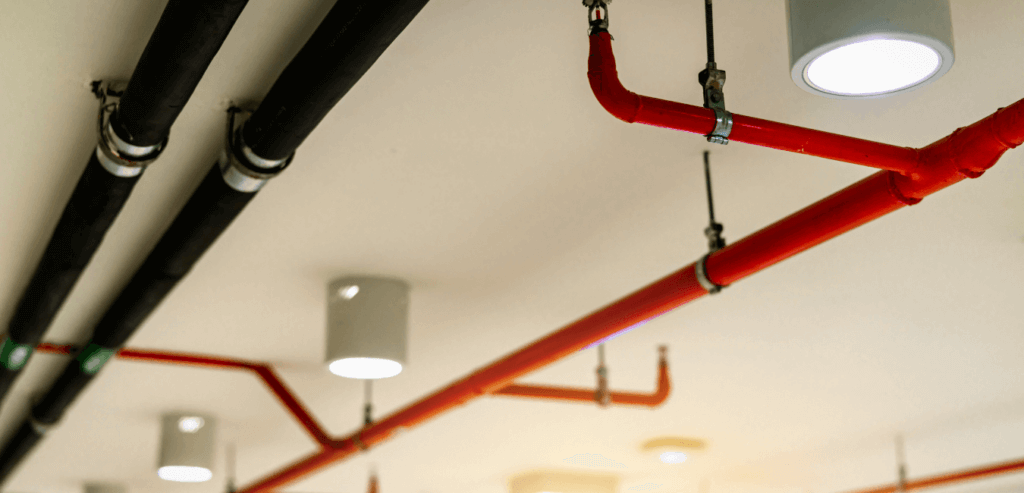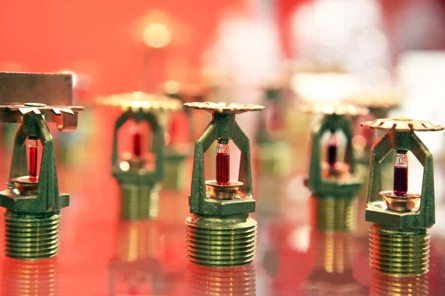If a fire breaks out in your business, acting fast could save you from costly damage and loss. That’s why commercial fire sprinkler systems are so important.
Myths about fire sprinklers exist, despite their obvious benefits. We’re dispelling commercial fire sprinkler system myths.
MYTH: Fire Sprinklers Cause Costly Damage
FACT: Sprinkler systems are more cost-effective, according to the Federal Emergency Management Agency. Experts design sprinkler systems to target and control the source of the fire. Sprinklers prevent the fire from expanding. They also keep you from needing a hose to extinguish the fire.
Sprinklers confine fire to one room in 96% of fires, according to National Fire Protection Association research.
Quick-response sprinklers release eight to 24 gallons of water per minute. A fire hose releases 50 to 125 gallons per minute. A commercial fire sprinkler system keeps the fire in one room, limiting clean-up.
MYTH: One Fire Sprinkler Triggers Them All
FACT: A heat-sensitive glass bulb filled with a liquid or a two-part metal alloy holds fire sprinkler heads in place. The glass bulb or link applies pressure to a pipe cap, preventing water from flowing through the system. Each sprinkler head activates one by one if a fire occurs. This activation occurs when the nozzle reaches 135 to 165 degrees.
So when one sprinkler goes off, only the heads that sense high heat activate.
Due to their design, it’s unusual for a sprinkler head to trigger randomly. Six or fewer sprinkler heads control 90% of fires, according to FEMA. In addition, one or two sprinkler heads control 82% of fires, according to FEMA.
MYTH: Sprinklers Activate Needlessly
FACT: Fire sprinklers only activate when they detect high heat. An employee burning their lunch or taking a smoke break will not set off a sprinkler system.
Only one in 16 million sprinkler heads activate accidentally, making their benefits far outweigh any risks.
MYTH: Sprinkler Systems Break Down and Fail
Sprinkler systems rarely break down. But they also aren’t foolproof, especially when you consider human error.
Causes of system failures include:

System Shut Offs
Fifty-nine percent of sprinkler failures occur because someone shut off the equipment. For example, you turn off the sprinklers because the building is vacant or there is a system leak.
Faulty wiring or vandals can start a fire in a vacant building. If you aren’t using your building, don’t shut
off the sprinklers. If your system is leaking, have it repaired.
Manual Intervention
Nearly 20% of sprinkler failures are due to manual intervention. Manual intervention means someone shut off a system after the fire started.
Employees think they’re helping by not having the sprinkler systems activated. But, they may not see the extent of the fire, and shutting off the system prevents it from doing its job.
Manual intervention also occurs when someone puts an obstruction in the sprinkler head’s path. This type of intervention usually results from poor design or carelessness. Common obstructions include cubicles, piping, ducts, light fixtures, or piled high storage.
Damaged Components
Fire sprinkler manufacturers test sprinklers before they sell them. Unfortunately, defective fire sprinklers make their way into service. But, production defects only contribute to 7% of sprinkler system failures.
Shipping and installation also can damage sprinklers. Regular inspection and testing can help you catch system damage.
Lack of Maintenance
Six percent of sprinkler failure is due to a lack of maintenance. To keep your sprinkler system working requires regular upkeep and annual testing. This upkeep includes checking the pressure pipes, inspecting the sprinkler system heads, and looking for leaks or valve malfunctions.
Improper Systems
Improper system design or the wrong type of agent causes 5% of sprinkler system failures. You should consult a professional when deciding on a sprinkler system for your building.
How ServiceMaster Restoration Can Help
The team at ServiceMaster Restoration can help after your structure experiences fire, smoke, or water damage. Our five-step process can help you get your business back up and running.
The five steps are:
- Step 1: Emergency Pre-Cleaning. Our pre-cleaning services take place within 24 hours of an incident. The quick response assesses the impact and minimizes further damage to your space.
- Step 2: Content Pack Out. We inventory and relocate building contents. We move materials to a climate-controlled setting.
- Step 3: Content Cleaning. Our network of partners cleans, deodorizes, and dries your building’s contents.
- Step 4: Structure Cleaning. Our team of pros uses the most advanced equipment available to clean your building’s damaged areas.
- Step 5: Deodorization. We implement a deodorization plan, based on the extent of the fire and smoke damage.
Safety and protection are essential to keeping your operations going smoothly. Install commercial sprinklers and place fire extinguishers throughout your building to help keep it safe from workplace fires.
If the unexpected happens, know you’re not alone. ServiceMaster Restoration is committed to helping you. Our fire, smoke, and water damage clean-up services get your doors back open fast. Contact us. We’re available 24/7/365 to help.


